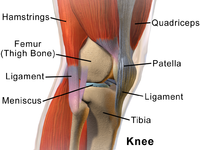
Photo from wikipedia
Abstract Background Knee osteoarthritis affects nearly 30% of adults aged 60 years or older and causes significant pain and disability. Walking is considered a “gold standard” treatment option for reducing… Click to show full abstract
Abstract Background Knee osteoarthritis affects nearly 30% of adults aged 60 years or older and causes significant pain and disability. Walking is considered a “gold standard” treatment option for reducing knee osteoarthritis pain and maintaining joint mobility but does not reduce pain for all adults with knee osteoarthritis pain and may induce pain—particularly when starting a walking routine. The mechanism by which walking is helpful for knee osteoarthritis pain is unclear. Quantitative sensory testing has revealed that knee osteoarthritis pain has both peripheral and central components, which vary by individual. Objective The purpose of this study was to better understand the mechanisms underlying the value of walking for knee pain. Methods We conducted a pretest/posttest study using quantitative sensory testing to measure neurophysiological parameters and examined systemic protein signatures. Adults with knee osteoarthritis and healthy controls underwent quantitative sensory testing and blood draw for platelet proteomics before and after a 30-minute walk at 100 steps per minute. Results A single 30-minute walk moderately increased pressure pain sensitivity at the affected knee among persons with knee osteoarthritis. Healthy adults showed no difference in pain sensitivity. Protein signatures among participants with knee osteoarthritis indicated changes in inflammatory and immune pathways, including the complement system and SAA1 protein that coincided with changes in pain with walking and differed from healthy participants. Discussion One goal of developing individualized interventions for knee osteoarthritis pain is to elucidate the mechanisms by which self-management interventions affect pain. The addition of therapies that target the complement system or SAA1 expression may improve the pain sensitivity after a moderate walk for adults with knee osteoarthritis.
Journal Title: Nursing Research
Year Published: 2022
Link to full text (if available)
Share on Social Media: Sign Up to like & get
recommendations!